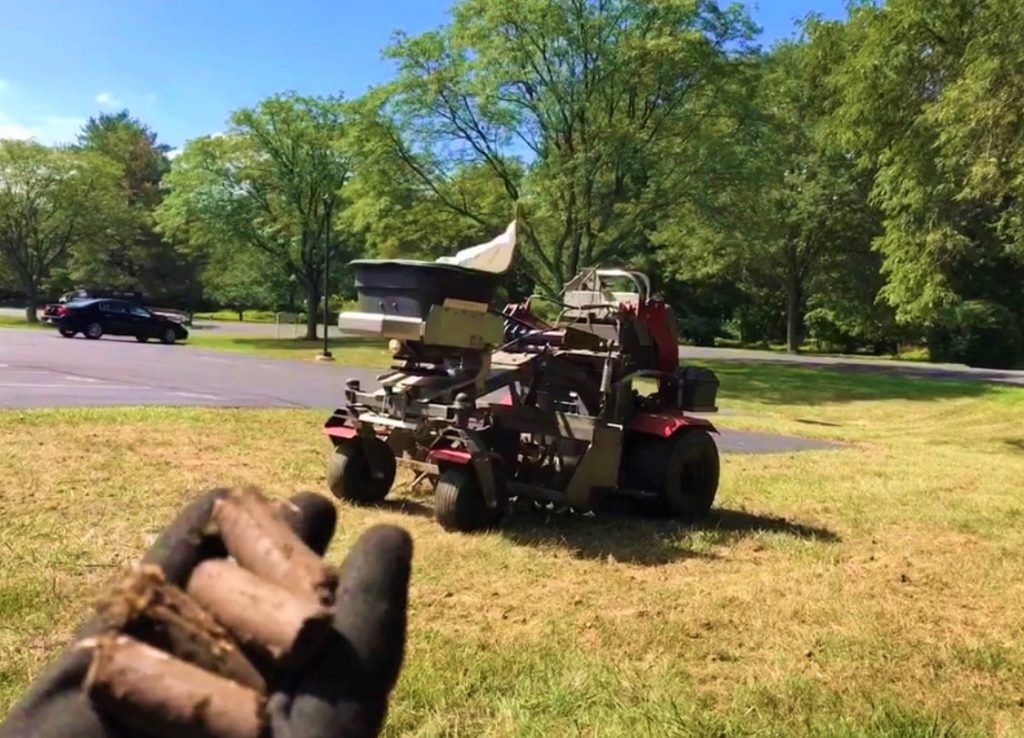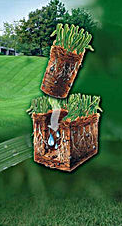7 Aeration and Overseeding Mistakes You Should Avoid
We all want a bright green lawn, but after a harsh summer or winter, your turf is likely a little dull, thin or patchy.
To revitalize your grass, you may consider aerating and overseeding, or creating holes in your soil to plant fresh seedlings. In fact, when done correctly, aerating and overseeding can be extremely beneficial to the wellbeing of your turf. Unfortunately, mistakes can be all too easy to make— and could cost time and money, with little return.
Be sure to avoid these seven aeration and overseeding mistakes to get the thick, healthy look you desire:

1. You don’t choose the right equipment.
We’ve all seen the do-it-yourselfers walking across their lawn in cleats, poking holes in the soil. Instead of investing in an aeration machine, they think aerating is just about creating holes— but actually, the concentrated force of stepping with a spiked shoe further compacts your soil. Even spike aerators, which use a solid tine or fork to poke holes, can cause additional compaction in the areas around the holes.
For best results, use a plug aerator, which removes a core, or plug, of grass and soil from your lawn. Look for an aerating tool or machine that removes soil plugs approximately two to three inches deep and roughly half to three quarters of an inch in diameter, about two to three inches apart.
2. You don’t know how to use your aeration machine and accidentally damage your turf.
After you choose the right aeration equipment, much of the success of your new growth will be the result of how well you operate the aerator. Walk-behind aerators are a common choice but can be heavy to push. Large lawns can mean achy arms and sloppy navigating, resulting in inconsistent growth.

In addition, during each turn, you must disengage the tines by lifting up from the handle to prevent damaging the turf. This can be time-consuming, so instead, some operators will lift and spin the whole unit when it’s time to turn, potentially causing compaction and bare spots later on. Make sure you choose the right machine and understand how to use it to ensure the best results for your lawn.
3. You aerate and overseed during the wrong time of the year.
The proper time to aerate is when new life has the greatest chance to grow in your region. You wouldn’t want to aerate and overseed too early, before the last frost hits for example, and kill the seeds. You also wouldn’t want to do it during the peak of a hot summer, when the harsh sun and temperature suppress new growth.
For cool-season grasses, common in northern lawns, aerate early fall or spring. Warm-season grasses, common to southern lawns, grow best in the late spring or very early summer. Not sure which applies to you? Here in Pennsylvania, cool air and moist soil in the fall and spring make it the perfect time to lay fresh turf, helping to build greater resistance against disease, insects, and drought.

4. You aerate and overseed during dry conditions.
Aerating is easy on your turf, and you, when your soil is slightly moist. Overly dry and compact soil is harder to penetrate and requires more manual effort to push the machinery. Especially during times of drought when you grass is already stressed, it’s best to wait until the day after a good rainfall before aerating.
5. You don’t keep your lawn moist after aerating and overseeding.
After planting the seeds, you must make sure they’re covered with moist soil— at least a fourth of an inch— to foster growth. A common mistake rookie aerators and overseeders make is thinking that the natural rain cycle will provide all the water you need, but a few days without moisture could mean bad news for a new seed.
For about three weeks after seeding, or until the grass begins to peek out of the dirt, set a daily watering schedule. Once the grass has gained a little height, you can ease back to your normal pattern.
6. You mow too soon.
After you lay down your seedlings, they’ll need time and the right environmental protection to grow. They’ll need to acclimate and set roots before the first mow, so during the first two to four weeks post aerating and overseeding, don’t mow. This time varies depending on your area and the type of grass you planted; for example, fescue and ryegrass typically take about 10 to 14 days to germinate, while Kentucky bluegrass might take up to four weeks. A lawn care professional can advise you on the right timespan.

During this sensitive time of growth, try to allow avoid heavy foot traffic on your property, which could compact the seeds too deeply. Once the grass reaches about three to three and half inches, you can fire up the mower for a fresh cut.
7. You fight weeds too early.
Weed control can work wonders keeping invasive growth at bay on a healthy turf, but chemicals and herbicides can harm seeding’s roots and fresh blades. Even organic and natural solutions can cause stress on the young plants, so it’s often best to wait until your grass is strong before laying down any weed control substances. We advise waiting until you’ve mowed your new grass four to five times before tackling any emerging weeds.
Sometimes, It’s Better to Trust a Professional
Being mindful of these seven aeration and overseeding mistakes can certainly help create the beautiful turf you long for, but landscape maintenance can be time-consuming— and there’s a lot of dos and don’ts along the way!
A lawn care professional will know the right equipment and understand the needs of your unique property. Our team at Caramanico is here to get the job done right and prepare your turf for vibrant growth for your commercial property. Give us a call at 610.499.1640 or fill out this form to get a free property assessment today.
Properties We Serve: Businesses, Colleges & Universities, High Schools & Elementary Schools, Shopping Centers, Apartments & Condominiums, Retirement Communities, Golf Courses & Country Clubs, Medical Centers, and more!
Service areas: Chester County, Pennsylvania; Delaware County, Pennsylvania; Montgomery County, Pennsylvania; Philadelphia County, Pennsylvania; Bucks County, Pennsylvania; Hunterdon County, New Jersey; Somerset County, New Jersey; Mercer County, New Jersey; Camden County, New Jersey; Gloucester County, New Jersey; New Castle County, Delaware
